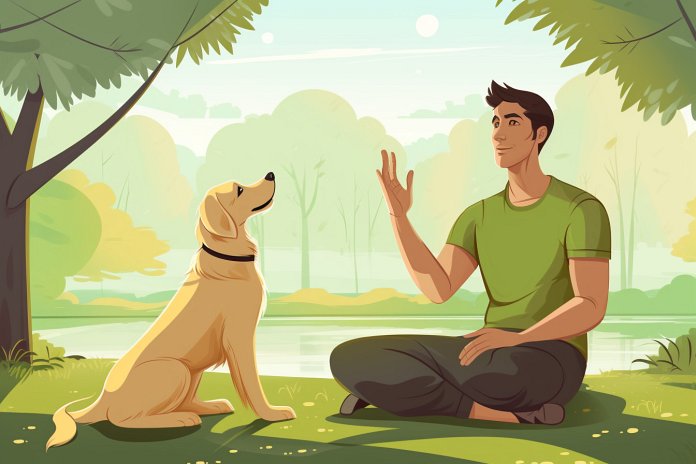
Understanding whether dogs can comprehend commands is a seemingly simple topic, but it has complexities. While dogs can be trained to understand commands from a young age, not all dogs have the same ability to comprehend. This raises questions about the role of breeds and the importance of early training. In this article, we will explore the evidence and provide answers to these pressing questions.
Can dogs understand commands?
Let’s see what we can find.
Signs Your Dog Can Understand Your Commands
Most dogs can understand up to 165 words, equivalent to the average intelligence of a human toddler. Dogs are not only capable of understanding words but also processing and analyzing responses. However, dogs may not be accustomed to your style of communication if you have just acquired a puppy or an older dog. Training them involves teaching them through your voice, treatment, and actions. It requires perseverance and constant training.
Dogs can be trained using sounds, words, commands, hand signals, or other actions. This enables them to understand and respond to their trainers. Some dogs can become special companions and service dogs, helping individuals live a normal life. Dogs can understand commands related to eating, playing, and going to the park with ease. These simple commands are enjoyable for dogs and serve as incentives for them to behave well, especially in public. Basic commands like “Sit,” “Stay,” and “Fetch” are common and can be reinforced with treats or rewards, which dogs love.
Body Language
Key signs that indicate your dog understands a command include staring, alertness, head tilting, and raised ears. Other clues include leaning forward, standing on tip-toes, and obeying the command.
The History of Dogs Learning Commands
Before dogs became household pets, they were used for farming, hunting, messaging, and warfare. Dogs had to understand and respond to various commands given by their handlers. As humans became more versatile and educated, training methods evolved. Dogs are still used today by law enforcement, armies, and as service dogs. Training dogs on commands is possible for any breed, as long as the owner is caring and responsible.
Science of Dogs Understanding Commands
A study published in the journal “Science” conducted MRI scans on dogs while they were spoken to. The researchers found that dogs’ brains assimilate information similarly to humans, with the right brain processing emotion and the left brain understanding meaning. When dogs heard praise and both parts of their brains aligned, they became truly happy. The right brain processes intonation, while the left brain processes the meaning of words.
Training Dogs on Understanding Commands
Teaching dogs commands is a vast field that cannot be fully covered in this article. However, the most essential commands to teach your dog are “sit,” “stay,” “leave it,” “come,” and “down.” These commands encourage good behavior and are necessary for proper socialization in public. By teaching these simple commands, you can strengthen your bond with your dog and progress to more complex commands.
It is important to speak to your dog in a low tone and without raising your voice. Speaking commands with authority but gentleness allows your dog to obey without feeling punished. Keeping training sessions short (less than 3 minutes with hourly breaks) helps dogs learn while having fun and expressing themselves in a relaxed manner.
“Training your dog is a journey of understanding, where commands and body language create a bond that transcends words.”

Tips & Things to Know
1️⃣ Training your dog from a young age is important for them to develop an understanding of commands. However, even older dogs can learn and adapt to your style of communication with patience and perseverance.
2️⃣ Dogs can understand up to 165 words on average and have the ability to process and analyze responses. They can be trained using sounds, words, commands, hand signals, or other actions. Simple commands related to eating, playing, and going to the park are enjoyable for dogs and serve as great incentives for them to become well-behaved, especially in public.
3️⃣ Body language plays a crucial role in understanding if your dog comprehends a command. Signs such as staring, alertness, head tilting, and raised ears indicate their understanding. Other clues include leaning forward, standing on tip-toes, and obediently following the command. Speaking commands with authority but gentleness, using a low tone without raising your voice, can help your dog obey without feeling punished. Keeping training sessions minimal and fun, with breaks in between, allows the dog to learn and express themselves in a relaxed way.
Frequently Asked Questions, Answered ✅
1. Can all dogs understand commands?
– No, while most dogs can understand commands, some may not have the same ability to understand as others.
2. Is training a dog from a young age important for their understanding of commands?
– Yes, training a dog from a young age helps them develop a healthy appreciation of commands and obedience.
3. How can a dog develop a healthy appreciation of commands and obedience?
– Dogs can develop a healthy appreciation of commands and obedience through perseverance and constant training, as well as using sounds, words, commands, hand signals, or other actions.
4. What are some signs that a dog understands a command?
– Some signs that a dog understands a command include staring, alertness, head tilting, raised ears, leaning forward, standing on tip-toes, and obeying the command.
5. How do dogs process and understand commands?
– Dogs’ brains assimilate information similar to humans, with the right brain dealing with emotion and the left brain understanding meaning. Dogs largely process intonation (how it sounds) with the right brain and the meaning of the word with the left brain.